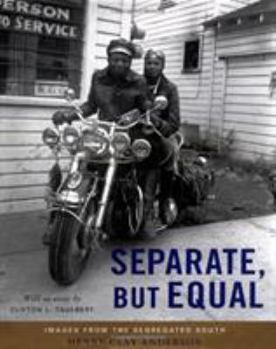Separate, But Equal: Images from the Segregated South
Select Format
Select Condition 
Book Overview
As the nation reflects on the Supreme Court's 1954 ruling against "separate, but equal," this remarkable book of photographs reveals the realities of segregated life for urban blacks in the South.... This description may be from another edition of this product.
Format:Hardcover
Language:English
ISBN:158648236X
ISBN13:9781586482367
Release Date:April 2004
Publisher:PublicAffairs
Length:151 Pages
Weight:0.95 lbs.
Dimensions:0.8" x 8.4" x 10.3"
Customer Reviews
2 ratings
A successful black community
Published by Thriftbooks.com User , 20 years ago
During the middle of the twentieth century, American black and white people lived in separate communities by law. White people never entered black areas while black people only entered white areas if they were employed as butlers or maids. This segregation created many impoverished black ghettos but there were a few black communities that prospered and this book is about one of them, in Greenville, in the American state of Mississippi. The inspiration for - and focus of - the book is the collection of photographs by Henry Clay Anderson who died in 1998, a few months after selling that collection to Shawn Wilson. These photographs show successful black people going about their normal lives at school, at home, at weddings and a variety of other everyday situations as well as photographs taken in a studio. Most of these photographs would be unremarkable if they were of white people, but because most photographs of black people are of the poor and oppressed, these photographs may come as a revelation to some. Supporting text by Clifton L. Taulbert, who remembers the area from his childhood (he was raised in a nearby community), explains what Greenville was like during the period in which these photographs were taken. Greenville is not one of America's more famous locations. I only recognize the name because it is mentioned in a song that I know well - Mississippi, by the Dutch pop group, Pussycat. As this book is about a particular period in Greenville's history, I (and I'm sure many readers of this book) would have appreciated the inclusion of a chapter about Greenville's history and culture to set this book in context, explaining what it was like before the period covered and hw things have changed since. In its absence, I have to drop the book (otherwise easily worth five stars), to four stars. Another chapter is devoted to the rise of the civil rights movement and the murder of the Reverend Gus Lee, accompanied by some dramatic photographs that are not typical of the rest of the book, which set out to portray the good aspects of black people's lives. However, bad things happen to everybody and it was necessary to cover this episode in the book. This book, despite the murder, shows that black people can be very successful. It's the kind of book that shouldn't be necessary and it's a sad reflection on society that it was felt necessary to publish this book.
BLACK MIDDLE CLASS LIFE UNDER JIM CROW IN THE DEEP SOUTH...
Published by Thriftbooks.com User , 20 years ago
This book is a moving pictorial testament to the daily life of middle class blacks in the deep South in the time of Jim Crow, as well as on the cusp of the civil rights movement. It is a slice of black life with which most whites at the time were unfamiliar, as most photo-journalists chose to capture the more sensational types of images in the black community.Henry Clay Anderson was a black school teacher and minister who, courtesy of the G. I. Bill, studied photography and became a professional photographer. In 1948, he established his own business, Anderson Photo Service, in Greenville, Mississippi, where he lived. For more than forty years, he would photograph moments in the lives of Greenville's black middle class community, forever freezing in time images of a rich life that paralleled those of their white counterparts in the Jim Crow South, separate but equal. The book has one hundred and thirty of his photographs, memorializing a time long past but one that continues to haunt America today. Clifton L. Taulbert, who was raised in Mississippi in a town not far from Greenville and is the noted author of the book, "Once Upon a Time When We Were Colored", writes a poignant and moving essay in remembrance of the black denizens of Greenville, grounding the photographs in the context of the times out of which they arose. It is as if it were a walk down memory lane. Mary Panzer, curator of photographs at the National Portrait Gallery in Washington, D.C., writes an essay that details Mr. Anderson's photographic involvement in the early civil rights movement, when he agreed to go travel to Belzoni, Mississippi in 1955. Belzoni had been the scene of the grisly shooting of Rev. Gus Lee, a black civil rights activist who had been involved in voter registration efforts. Mr. Anderson's photographs memorialized the shooting and its aftermath, appearing in magazines such as "Jet" and "Ebony", which were well known in the black community. Ms. Panzer grounds his photographs in the political context of the time, which affirm Mr. Anderson's political commitment.There are also two essays in Mr. Anderson's own words that are culled from two interviews conducted by Daisy Greene for the Washington County Oral History Project and by Shawn Wilson, in whom the idea for this book germinated. The book is a loving tribute to Henry Clay Anderson. His legacy of photographic images will delight and haunt those who look at them, seeing in them not only America's past but its future. This is simply a beautiful book.






